This document discusses algorithms and techniques for computing the Stanley depth of monomial ideals. It begins by introducing some key concepts such as squarefree monomial ideals and the Stanley depth. It then describes an approach for computing the Stanley depth of a squarefree monomial ideal by partitioning the collection of subsets of variables into non-colliding intervals. The document presents pseudocode for expanding an interval into its constituent sets. It also references several related papers on algorithms for computing Stanley depth and bounds on the Stanley depth of certain classes of monomial ideals.



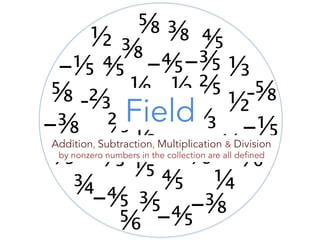

![If K is a field,
the polynomial ring in n variables,
denoted K [ x1,...,xn ],
consists of all polynomials
where the coefficients come
from the field K
and the variables x1,x2,...,xn
are all allowed to appear.](https://image.slidesharecdn.com/a2e755d6-d4b5-4c98-addb-a62d84363d0b-160612230652/85/SRS-presentation-Stanley-Depth-6-320.jpg)
![K is the rational numbers
½x1
3x2 −3x3 +7x1
&
⅝x1
100 −5x3 +6
examples of polynomials in
K [x1,x2,x3]](https://image.slidesharecdn.com/a2e755d6-d4b5-4c98-addb-a62d84363d0b-160612230652/85/SRS-presentation-Stanley-Depth-7-320.jpg)




![If A and B are subsets of {1, 2, . . . , n},
the interval [A, B] contains every set T such that
A is a subset of T and T is a subset of B.
(We call B the upper bound of the interval.)
[ {1, 2}, {1, 2, 4, 6} ]
{1, 2}, {1, 2, 4}, {1, 2, 6}, {1, 2, 4, 6}
{1, 2, 5} and {2, 4, 6} is not in this interval](https://image.slidesharecdn.com/a2e755d6-d4b5-4c98-addb-a62d84363d0b-160612230652/85/SRS-presentation-Stanley-Depth-12-320.jpg)
![Two intervals collide if they have
at least a set in common.
[{1, 6}, {1, 6, 2, 3}] [{1, 3}, {1, 3, 6, 9}]
{1, 3, 6}
Collision
{1, 6}
{1,6,2}
{1, 6, 2, 3}
{1, 3} {1,3,9}
{1, 3, 6, 9}](https://image.slidesharecdn.com/a2e755d6-d4b5-4c98-addb-a62d84363d0b-160612230652/85/SRS-presentation-Stanley-Depth-13-320.jpg)





![expand_interval
Input: [{3, 4}, {3, 4, 6, 7, 8}]
Output: {{3,4}, {3,4,6}, {3,4,7}, {3,4,8}, {3,4,6,7},
{3,4,6,8}, {3,4,7,8}, {3,4,6,7,8}}](https://image.slidesharecdn.com/a2e755d6-d4b5-4c98-addb-a62d84363d0b-160612230652/85/SRS-presentation-Stanley-Depth-19-320.jpg)
![expand_interval
Input: [{3, 4}, {3, 4, 6, 7, 8}]
Output: {{3,4}, {3,4,6}, {3,4,7}, {3,4,8}, {3,4,6,7},
{3,4,6,8}, {3,4,7,8}, {3,4,6,7,8}}
{ }
{3}
{4}
{6}
{7}
{8}
{3, 4}
{3, 6}
{3, 7}
{3, 8}
{4, 6}
{4, 7}
{4, 8}
{6, 7}
{6, 8}
{7, 8}
{3, 4, 6}
{3, 4, 7}
{3, 4, 8}
{3, 6, 7}
{3, 6, 8}
{3, 7, 8}
{4, 6, 7}
{4, 6, 8}
{4, 7, 8}
{6, 7, 8}
{3, 4, 6, 7}
{3, 4, 6, 8}
{3, 4, 7, 8}
{3, 6, 7, 8}
{4, 6, 7, 8}
{3,4,6,7,8}
Powerset of {3, 4, 6, 7, 8}](https://image.slidesharecdn.com/a2e755d6-d4b5-4c98-addb-a62d84363d0b-160612230652/85/SRS-presentation-Stanley-Depth-20-320.jpg)
![expand_interval
Input: [{3, 4}, {3, 4, 6, 7, 8}]
Output: {{3,4}, {3,4,6}, {3,4,7}, {3,4,8}, {3,4,6,7},
{3,4,6,8}, {3,4,7,8}, {3,4,6,7,8}}
{ }
{3}
{4}
{6}
{7}
{8}
{3, 4}
{3, 6}
{3, 7}
{3, 8}
{4, 6}
{4, 7}
{4, 8}
{6, 7}
{6, 8}
{7, 8}
{3, 4, 6}
{3, 4, 7}
{3, 4, 8}
{3, 6, 7}
{3, 6, 8}
{3, 7, 8}
{4, 6, 7}
{4, 6, 8}
{4, 7, 8}
{6, 7, 8}
{3, 4, 6, 7}
{3, 4, 6, 8}
{3, 4, 7, 8}
{3, 6, 7, 8}
{4, 6, 7, 8}
{3,4,6,7,8}
Powerset of {3, 4, 6, 7, 8}](https://image.slidesharecdn.com/a2e755d6-d4b5-4c98-addb-a62d84363d0b-160612230652/85/SRS-presentation-Stanley-Depth-21-320.jpg)
![expand_interval
Input: [{3, 4}, {3, 4, 6, 7, 8}]
Output: {{3,4}, {3,4,6}, {3,4,7}, {3,4,8}, {3,4,6,7},
{3,4,6,8}, {3,4,7,8}, {3,4,6,7,8}}
{3,
4}
{3,
4,
6}
{3,
4,
7}
{3,
4,
8}
A](https://image.slidesharecdn.com/a2e755d6-d4b5-4c98-addb-a62d84363d0b-160612230652/85/SRS-presentation-Stanley-Depth-22-320.jpg)
![expand_interval
Input: [{3, 4}, {3, 4, 6, 7, 8}]
Output: {{3,4}, {3,4,6}, {3,4,7}, {3,4,8}, {3,4,6,7},
{3,4,6,8}, {3,4,7,8}, {3,4,6,7,8}}
{3,
4,
6,
7}
{3,
4,
6,
8}
{3,
4,
7,
6}
{3,
4}
{3,
4,
6}
{3,
4,
7}
{3,
4,
8}
A](https://image.slidesharecdn.com/a2e755d6-d4b5-4c98-addb-a62d84363d0b-160612230652/85/SRS-presentation-Stanley-Depth-23-320.jpg)
![expand_interval
Input: [{3, 4}, {3, 4, 6, 7, 8}]
Output: {{3,4}, {3,4,6}, {3,4,7}, {3,4,8}, {3,4,6,7},
{3,4,6,8}, {3,4,7,8}, {3,4,6,7,8}}
{3,
4,
6,
7}
{3,
4,
6,
8}
{3,
4,
7,
6}
{3,
4}
{3,
4,
6}
{3,
4,
7}
{3,
4,
8}
A](https://image.slidesharecdn.com/a2e755d6-d4b5-4c98-addb-a62d84363d0b-160612230652/85/SRS-presentation-Stanley-Depth-24-320.jpg)
![expand_interval
Input: [{3, 4}, {3, 4, 6, 7, 8}]
Output: {{3,4}, {3,4,6}, {3,4,7}, {3,4,8}, {3,4,6,7},
{3,4,6,8}, {3,4,7,8}, {3,4,6,7,8}}
{3,
4,
6,
7}
{3,
4,
6,
8}
{3,
4,
7,
6}
{3,
4,
7,
8}
{3,
4}
{3,
4,
6}
{3,
4,
7}
{3,
4,
8}
A
{3,
4,
8,
6}](https://image.slidesharecdn.com/a2e755d6-d4b5-4c98-addb-a62d84363d0b-160612230652/85/SRS-presentation-Stanley-Depth-25-320.jpg)
![expand_interval
Input: [{3, 4}, {3, 4, 6, 7, 8}]
Output: {{3,4}, {3,4,6}, {3,4,7}, {3,4,8}, {3,4,6,7},
{3,4,6,8}, {3,4,7,8}, {3,4,6,7,8}}
{3,
4,
6,
7}
{3,
4,
6,
8}
{3,
4,
7,
6}
{3,
4,
7,
8}
{3,
4}
{3,
4,
6}
{3,
4,
7}
{3,
4,
8}
A
{3,
4,
8,
6}
{3,
4,
8,
7}](https://image.slidesharecdn.com/a2e755d6-d4b5-4c98-addb-a62d84363d0b-160612230652/85/SRS-presentation-Stanley-Depth-26-320.jpg)
![expand_interval
Input: [{3, 4}, {3, 4, 6, 7, 8}]
Output: {{3,4}, {3,4,6}, {3,4,7}, {3,4,8}, {3,4,6,7},
{3,4,6,8}, {3,4,7,8}, {3,4,6,7,8}}
{3,
4,
6,
7}
{3,
4,
6,
8}
{3,
4,
7,
6}
{3,
4,
7,
8}
{3,
4}
{3,
4,
6}
{3,
4,
7}
{3,
4,
8}
A
{3,
4,
8,
6}
{3,
4,
8,
7}](https://image.slidesharecdn.com/a2e755d6-d4b5-4c98-addb-a62d84363d0b-160612230652/85/SRS-presentation-Stanley-Depth-27-320.jpg)
![expand_interval
Input: [{3, 4}, {3, 4, 6, 7, 8}]
Output: {{3,4}, {3,4,6}, {3,4,7}, {3,4,8}, {3,4,6,7},
{3,4,6,8}, {3,4,7,8}, {3,4,6,7,8}}
{3,
4,
6,
7}
{3,
4,
6,
8}
{3,
4,
7,
6}
{3,
4,
7,
8}
{3,
4}
{3,
4,
6}
{3,
4,
7}
{3,
4,
8}
A
{3,
4,
8,
6}
{3,
4,
8,
7}
{3,
4,
6,
7,
8}
B](https://image.slidesharecdn.com/a2e755d6-d4b5-4c98-addb-a62d84363d0b-160612230652/85/SRS-presentation-Stanley-Depth-28-320.jpg)
![expand_interval
Input: [{3, 4}, {3, 4, 6, 7, 8}]
Output: {{3,4}, {3,4,6}, {3,4,7}, {3,4,8}, {3,4,6,7},
{3,4,6,8}, {3,4,7,8}, {3,4,6,7,8}}
{3,
4,
6,
7}
{3,
4,
6,
8}
{3,
4,
7,
6}
{3,
4,
7,
8}
{3,
4}
{3,
4,
6}
{3,
4,
7}
{3,
4,
8}
A
{3,
4,
8,
6}
{3,
4,
8,
7}
{3,
4,
6,
7,
8}
B](https://image.slidesharecdn.com/a2e755d6-d4b5-4c98-addb-a62d84363d0b-160612230652/85/SRS-presentation-Stanley-Depth-29-320.jpg)
![find_partition
Input: n = 8
Output: [[[1, 2], [1, 2, 3, 4]], [[2, 3], [2, 3, 4, 5]], [[3, 4], [3, 4,
5, 6]], [[4, 5], [4, 5, 6, 7]], [[5, 6], [5, 6, 7, 8]], [[6, 7], [6, 7, 8, 1]],
[[7, 8], [7, 8, 1, 2]], [[8, 1], [8, 1, 2, 3]], [[1, 3], [1, 3, 4, 5]], [[2, 4],
[2, 4, 5, 6]], [[3, 5], [3, 5, 6, 7]], [[4, 6], [4, 6, 7, 8]], [[5, 7], [5, 7,
8, 1]], [[6, 8], [6, 8, 1, 2]], [[7, 1], [7, 1, 2, 3]], [[8, 2], [8, 2, 3, 4]],
[[1, 4], [1, 4, 5, 6]], [[2, 5], [2, 5, 6, 7]], [[3, 6], [3, 6, 7, 8]], [[4, 7],
[4, 7, 8, 1]], [[5, 8], [5, 8, 1, 2]], [[6, 1], [6, 1, 2, 3]], [[7, 2], [7, 2,
3, 4]], [[8, 3], [8, 3, 4, 5]], [[1, 5], [1, 5, 2, 6]], [[2, 6], [2, 6, 3, 7]],
[[3, 7], [3, 7, 4, 8]], [[4, 8], [4, 8, 5, 1]]]
• No Collision
• Covers the whole Poset](https://image.slidesharecdn.com/a2e755d6-d4b5-4c98-addb-a62d84363d0b-160612230652/85/SRS-presentation-Stanley-Depth-30-320.jpg)


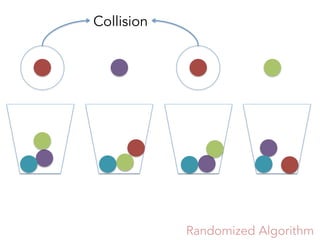




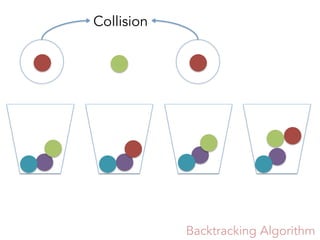

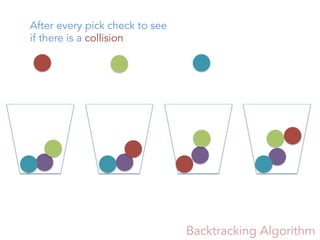

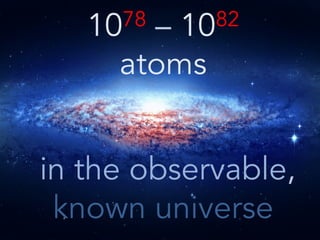
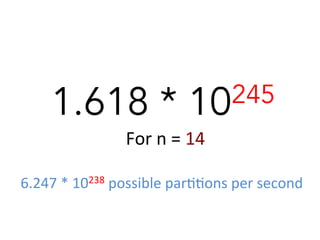
![Ring Diagram to make Intervals
1
2
3
4
5
6
7
8
[{1,2},{1,2,3,4}]
[A,
B]
n = 8
=
A
+
=
B](https://image.slidesharecdn.com/a2e755d6-d4b5-4c98-addb-a62d84363d0b-160612230652/85/SRS-presentation-Stanley-Depth-44-320.jpg)
![1
2
3
4
5
6
7
8
A single rotation
clockwise
n = 8
[{2,3},{2,3,4,5}]](https://image.slidesharecdn.com/a2e755d6-d4b5-4c98-addb-a62d84363d0b-160612230652/85/SRS-presentation-Stanley-Depth-45-320.jpg)

![ring_to_interval
Input: [1,1,2,2,0,0,0,0]
Output: [[[1, 2], [1, 2, 3, 4]], [[2, 3], [2, 3, 4, 5]], [[3, 4],
[3, 4, 5, 6]], [[4, 5], [4, 5, 6, 7]], [[5, 6], [5, 6, 7, 8]],
[[6, 7], [6, 7, 8, 1]], [[7, 8], [7, 8, 1, 2]], [[8, 1],
[8, 1, 2,3]]]
1
1
2
2
0
0
0
0
1
2
3
4
5
6
7
8
n = 8](https://image.slidesharecdn.com/a2e755d6-d4b5-4c98-addb-a62d84363d0b-160612230652/85/SRS-presentation-Stanley-Depth-47-320.jpg)


